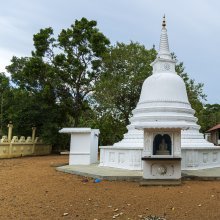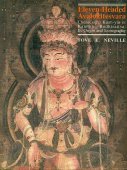Cetiya, Cetīya: 7 definitions
Introduction:
Cetiya means something in Buddhism, Pali, Hinduism, Sanskrit, the history of ancient India. If you want to know the exact meaning, history, etymology or English translation of this term then check out the descriptions on this page. Add your comment or reference to a book if you want to contribute to this summary article.
Alternative spellings of this word include Chetiya.
Images (photo gallery)
In Buddhism
Theravada (major branch of Buddhism)
Source: Dhamma Dana: Pali English GlossaryM Monument intended to remind the dhamma. Ideally, a cetiya is a reliquary, but it can also set texts or everything.
Theravāda is a major branch of Buddhism having the the Pali canon (tipitaka) as their canonical literature, which includes the vinaya-pitaka (monastic rules), the sutta-pitaka (Buddhist sermons) and the abhidhamma-pitaka (philosophy and psychology).
General definition (in Buddhism)
Source: Wisdom Library: BuddhismCetīya (चेतीय) (son of Upavara and father of Mucala) is the name of an ancient king from the Solar dynasty (sūryavaṃśa) and a descendant of Mahāsaṃmata, according to the Mahābuddhavaṃsa or Maha Buddhavamsa (the great chronicle of Buddhas) Anudīpanī chapter 1, compiled by Ven. Mingun Sayadaw. These twenty-eight kings were of long lives of asaṅkhyeyya (asaṃkhyeya) years. The twenty-seven kings [viz., Cetīya] after Mahāsammata were his descendants. Some of these twenty-eight kings reigned in Kusavatī City, others in Rājagaha and still others in Mithilā.
India history and geography
Source: Wikipedia: India HistoryCetiya is another name for Stupa: an outstanding type of architectural creation of ancient Sri Lanka. Under the influence of Buddhism, there were several changes in the field of architecture in Sri Lanka. The stupa commands a prominent place among these changes.
Source: Ancient Buddhist Texts: Geography of Early BuddhismCetiya (चेतिय) is the name of a mountain situated in Majjhimadesa (Middle Country) of ancient India, as recorded in the Pāli Buddhist texts (detailing the geography of ancient India as it was known in to Early Buddhism).—The Atthasālinī also refers to the Cetiya Pabbata which, however, is dfficult to be identified.

The history of India traces the identification of countries, villages, towns and other regions of India, as well as mythology, zoology, royal dynasties, rulers, tribes, local festivities and traditions and regional languages. Ancient India enjoyed religious freedom and encourages the path of Dharma, a concept common to Buddhism, Hinduism, and Jainism.
Languages of India and abroad
Pali-English dictionary
Source: Sutta: The Pali Text Society's Pali-English DictionaryCetiya, (nt.) (cp. from ci, to heap up, cp. citi, cināti) 1. a tumulus, sepulchral monument, cairn, M. I, 20; Dh. 188; J. I, 237; VI, 173; SnA 194 (dhātu-gharaṃ katvā cetiyaṃ patiṭṭhāpesuṃ); KhA 221; DhA. III, 29 (dhātu°); IV, 64; VvA. 142; Sdhp. 428, 430. Pre-Buddhistic cetiyas mentioned by name are Aggāḷava° Vin. II, 172; S. I, 185; Sn. p. 59; DhA. III, 170; Ānanda° D. II, 123, 126; Udena° D. II, 102, 118; III, 9; DhA. III, 246; Gotama (ka)° ibid. ; Cāpāla° D. II, 102, 118; S. V, 250; Ma- kuṭabandhana° D. II, 160; Bahuputta° D. II, 102, 118; III, 10; S. II, 220; A. IV, 16; Sattambaka° D. II, 102, 118; Sārandada D. II, 118, 175; A. III, 167; Supatiṭṭha° Vin. I, 35.
Source: BuddhaSasana: Concise Pali-English Dictionarycetiya : (nt.) a sepulchral monument; a pagoda.

Pali is the language of the Tipiṭaka, which is the sacred canon of Theravāda Buddhism and contains much of the Buddha’s speech. Closeley related to Sanskrit, both languages are used interchangeably between religions.
Sanskrit dictionary
Source: Cologne Digital Sanskrit Dictionaries: Edgerton Buddhist Hybrid Sanskrit DictionaryCetiya (चेतिय) or Ceti or Cetika or Caitya.—qq.v. (see § 3.115): ceti bhu (mss. bhū, Lefm. em. m.c., printing cetibhu as one word) trisahasraḥ kiṃ punas tubhya kāyaḥ Lalitavistara 368.18 (verse), the 3000-fold world has become (= abhūt) an [Page233-a+ 71] object of reverence (a shrine)…So Tibetan: stoṅ gsum (= 3,000) mchod rten (= caitya) gyur na (become)…
--- OR ---
Cetiya (चेतिय).—nt. or (when applied to a person) m. (= Pali id., Sanskrit caitya), sanctuary, temple; but also, object (of any kind) or person worthy of veneration; this form common in even the prose of Mahāvastu, only in verses of other texts; compare also ceti, cetika. In sense of a shrine (building) cāpālaṃ nāma cetiyaṃ Lalitavistara 388.12 = Mahāvastu iii.306.14 (verse); cāpālaṃ cetiyaṃ Mahāvastu i.299.22 (prose), and ff.; cetiyeṣu Mahāvastu i.223.11 = ii.26.8 (verse); other forms, ii.354.11; 364.11, 13; 365.20 ff.; iii.50.19; 303.1, etc.; cetiya- (mss. mostly cetiyaṃ-, perhaps read so; one ms. once cetika-)-pūjakaṃ (taṃ kulaṃ) Mahāvastu i.198.2 = ii.1.12 (prose), shrine-revering, of the family in which a Bodhisattva is born the last time (Lalitavistara 24.9 caitya-pūjakaṃ in same passage); of the Buddha himself, sarvalokasya cetiyo Mahāvastu ii.349.6; 359.8; iii.273.5, the Revered One of the whole world; lokasya cetiya (voc.) Mahāvastu ii.294.14; cetiyaṃ narāṇāṃ ii.296.13; lokacetiyaḥ Lalitavistara 97.10 (verse), of the Bodhisattva; utpanno iha loki cetiyo divi bhuvi mahitaḥ Lalitavistara 363.2 (verse), of the same; of the miraculously produced four bowls, dhāret' ime cetiya saṃmataite (so read with v.l., text °matīte) Lalitavistara 383.12, preserve them; they (shall be) honored as revered objects; cetiyārthe (so with mss.) Mahāvastu ii.263.12 (prose), for the purpose of (making it, viz. the spot where Buddha became enlightened) an object of veneration (universal emperors will never master, adhiṣṭhihanti with v.l., that spot except for this purpose).
Sanskrit, also spelled संस्कृतम् (saṃskṛtam), is an ancient language of India commonly seen as the grandmother of the Indo-European language family (even English!). Closely allied with Prakrit and Pali, Sanskrit is more exhaustive in both grammar and terms and has the most extensive collection of literature in the world, greatly surpassing its sister-languages Greek and Latin.
See also (Relevant definitions)
Starts with: Cetiya Jataka, Cetiya Sutta, Cetiya-vatthu, Cetiyadamila, Cetiyagabbha, Cetiyaghara, Cetiyagiri, Cetiyakapabbata, Cetiyam, Cetiyambatthala, Cetiyan, Cetiyangana, Cetiyapabbata, Cetiyavada, Cetiyavamsatthakatha, Cetiyavandana.
Ends with (+27): Acala Cetiya, Aggalavacetiya, Akasacetiya, Amalacetiya, Animisa Cetiya, Aramacetiya, Bahuputtacetiya, Capalacetiya, Civaracetiya, Culamanicetiya, Dhammacetiya, Dhatucetiya, Gotamakacetiya, Hemavalika Cetiya, Kalyani Cetiya, Kantaka Cetiya, Kantakacetiya, Kanthakanivatta Cetiya, Katthaka Cetiya, Mahacetiya.
Full-text (+191): Pathamacetiya, Capala, Nivattacetiya, Akasacetiya, Gotamakacetiya, Udenacetiya, Sarandadacetiya, Sattambacetiya, Bahuputtacetiya, Capalacetiya, Subhaddacetiya, Cetika, Markatahradatira, Katthakasala, Cetiyavandana, Cetiyavamsatthakatha, Rajamanicula Cetiya, Cecca, Ceti, Talapitthika Vihara.
Relevant text
Search found 22 books and stories containing Cetiya, Cetīya; (plurals include: Cetiyas, Cetīyas). You can also click to the full overview containing English textual excerpts. Below are direct links for the most relevant articles:
Mahavamsa (by Wilhelm Geiger)
The Great Chronicle of Buddhas (by Ven. Mingun Sayadaw)
Chapter 4 - Removing His Hair and becoming a Recluse < [Volume 2.1]
Buddha Chronicle 16: Siddhattha Buddhavaṃsa < [Chapter 9 - The chronicle of twenty-four Buddhas]
Buddha Chronicle 23: Koṇāgamana Buddhavaṃsa < [Chapter 9 - The chronicle of twenty-four Buddhas]
Dipavamsa (study) (by Sibani Barman)
The Bhikkhus Rules (by Bhikkhu Ariyesako)
Etiquette < [Chapter 5 - Miscellaneous]
Vinaya Pitaka (1): Bhikkhu-vibhanga (the analysis of Monks’ rules) (by I. B. Horner)
Monks’ Formal Meeting (Saṅghādisesa) 7
Monks’ Forfeiture (Nissaggiya) 1
Buddhist Education in Thailand (critical study) (by Smitthai Aphiwatamonkul)
1. Influences of Buddhism < [Chapter 3 - The Impact of Buddhist Education on Thai Sangha]
1. Buddhist Monastery in Thailand < [Chapter 4 - Role of the Buddhist Education in The Thai Society]
Related products

